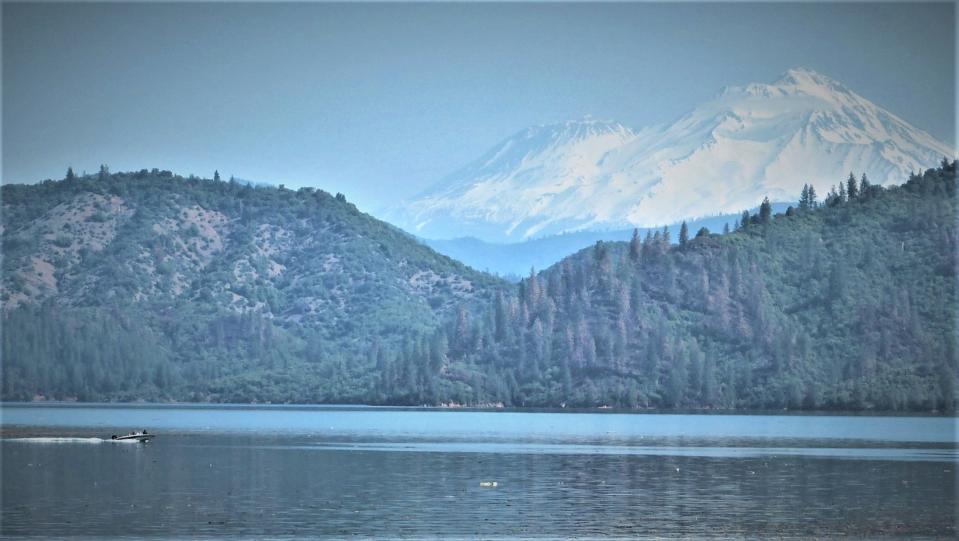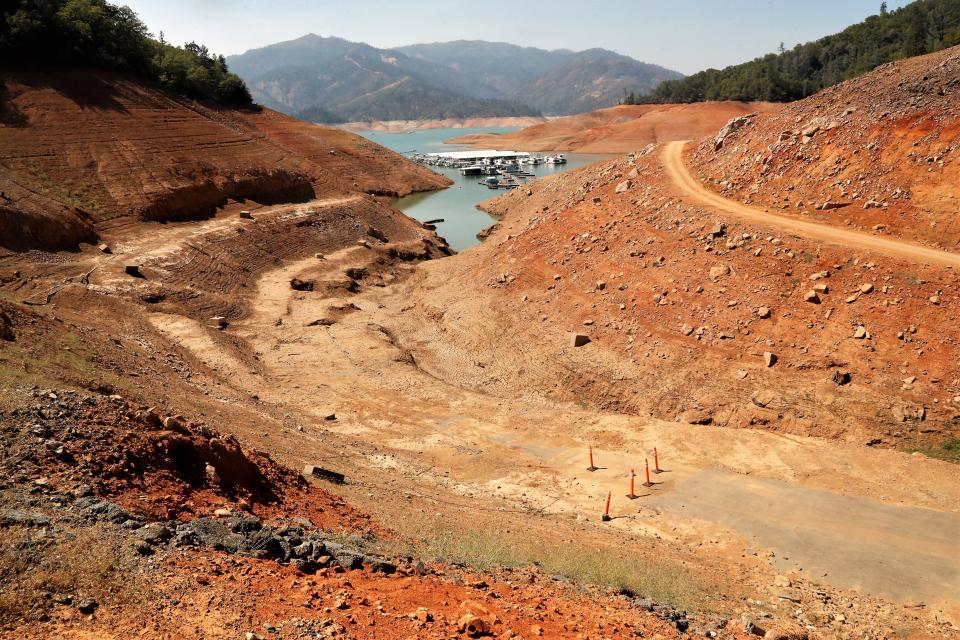How full are Lake Shasta, Trinity Lake and other reservoirs going into 2024?
A week into the new year, water levels at Shasta Dam and all but one other North State reservoir were above historic averages.
That's because rain and snowfall in spring 2023 are still helping repair North State lakes and their surrounding ecosystems after three years of drought damage, water and weather, experts said.
Spring rains and heavier than average snowpack in the mountains kept Lake Shasta’s water level high despite a rather dry autumn. “This bodes well in re-filling Shasta (Lake) with an average rainfall amount this winter,” Bureau of Reclamation Area Manager Donald Bader said.
As of Sunday Jan. 7, Lake Shasta was more than two thirds full, or 69%. Normally it’s 60% full at this time of year, Bader said.

Trinity Lake waters still lap at below-average levels ― as they have for more than three years. But if spring 2024 is a soaker, he said, that could finally change.
Water wise: What to expect in 2024 for Lake Shasta Reservoir
While it’s difficult to tell exactly what will happen throughout 2024, although the early forecast is for an average water year stretching from Oct. 1, 2023 to Sept. 30, 2024, according to the weather service.
Shasta County residents should expect most annual rainfall between January to March, the area’s usual rainy season, said meteorologist Johnnie Powell at the National Weather Service’s Sacramento branch.
That was the pattern in 2023, an unusually wet year throughout most of the North State, he said.
Average rainfall per water year in the Redding area from 1991 to 2020 was 33.52 inches, according to weather service meteorologist Sara Purdue.
"Average rainfall at Shasta Dam is 65 inches, double of what the Redding airport gets," Bader said.
But 2023 was no average year.
Spring storms made it the most wet calendar year since 2019, dropping enough water on the North State to fill most reservoirs to pre-drought levels by May, according to the California Department of Water Resources.
In 2023, the greatest amount of precipitation fell during January and March. Winter storms drenched the Lake Shasta area with 42 inches of rain during those two months, according to Powell.
February was drier, except for a major storm at the end of the month that dropped more than five inches of rain near the dam over a few days, Powell said.
Note to readers: If you appreciate the work we do here at the Redding Record Searchlight, please consider subscribing yourself or giving the gift of a subscription to someone you know.
By May 2023, Lake Shasta ― located about nine miles north of Redding ― was brimming at 98% of its capacity, 116% of its historic average, the water resources department reported.
Lake Shasta/Shasta Dam's water levels stayed above normal through summer and the area's dryer-than-average autumn, Powell said.
The 10 inches of rain that fell in December left Lake Shasta in excellent shape going into the new year, he said.
Trinity Lake water levels low while other North State reservoirs above average
Other Northern California reservoirs entered the new year with higher-than-average water levels, according to the water resources department. As of Sunday, Jan. 7:
Lake Oroville at Oroville Dam in Butte County was 69% full, 128% of its usual storage on that date.
Folsom Lake outside of Sacramento was 47% full, 113% of its average capacity.
At 63% full, Lake Sonoma in north Sonoma County was 110% above its historic average.
New Bullards Bar Reservoir in Yuba County is 64% full, a little above its annual average.
Not every lake fully recovered after the drought that desiccated the North State from 2020 to 2022.

Forty miles northwest of Redding, Trinity Lake’s water level was 54% full on Jan. 7. That’s 88% of the average amount of water the lake historically holds on that date, according to the state water resources department.
Trinity’s average level for this time of year is 61% full, according to Bader.
Prior to 2023, Trinity Lake had its worst consecutive three years of drought on record. The last time Trinity’s water level reached its historic average was 2019. The drought taxed the reservoir’s storage and one wet year couldn’t fully repair it, Bader said.
While Trinity Lake “got more water and snowmelt” in spring 2023 than it did “in the previous three years combined,” it will take another wet year to fill it to historic averages, he said.
That's because Trinity Lake fills more slowly than other Norths State reservoirs. While Lake Shasta has a big drainage basin that can fill the lake quickly, Trinity Lake is a large reservoir with a small basin, according to Bader.
As of Monday Jan. 8, “we are tracking a little below normal for both rain and especially snowpack out there. We will need to get well above average to have a good chance to fill" Trinity Lake reservoir, Bader said.
He’s still optimistic that could happen, he said.
“We ended this summer with much better carryover storage in both Trinity and Shasta than in the past three years. It's still early in the winter season,” and more storms are on the horizon, Bader said.
Jessica Skropanic is a features reporter for the Record Searchlight/USA Today Network. She covers science, arts, social issues and news stories. Follow her on Twitter @RS_JSkropanic and on Facebook. Join Jessica in the Get Out! Nor Cal recreation Facebook group. To support and sustain this work, please subscribe today. Thank you.
This article originally appeared on Redding Record Searchlight: How full are Lake Shasta and Trinity Lake? How much rain for 2024?

